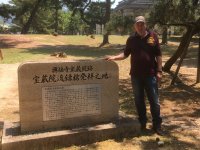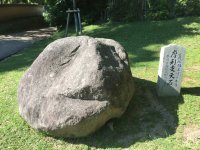Written by Kagita Chūbee, 20th sōke of the Hōzōinryū
Historical traces of the Hōzōinryū
As I already wrote in the previous issue, the Hōzōin was still in existence at the end of the Edo period1 and sōjutsu was still taught there then. But during the anti Buddhist movement at the beginnig of the Meiji period2 its buildings were torn down and its land was expropriated. At that time regrettably its dōjō was lost as well as the archives of its writings. Thus there are only very few historic monuments related to the Hōzōinryū that are left today, which I would like to introduce below.
 The memorial stone on the grounds of the Hōzōin
The memorial stone on the grounds of the Hōzōin
I always considered it very regrettable that almost nobody knew where the Hōzōin which was and is so renowned in the world of budō was actually located. So I approached the citizens of Nara with the idea of setting up a memorial stone and collected donations to that end. Tagawa Shunei, head of the Kōfukuji, contributed the calligraphy "Here stood the Hōzōin of the Kōfukuji, this is the birthplace of Hōzōinryū Sōjutsu", which was engraved in the stone which was set up in the west of the main building of the Nara National Museum on December 16th 2002.
The graveyard of the Hōzōin
The graveyard where Inei, the founder of our style, Inshun, the second headmaster, and their successors are resting is located in the Byakugōji quarter of Nara. The members of our school are visiting and maintaining the graves at all seasons. And every year on 26th of August, the day of Ineis death, a requiem mass is held which is attended by the head of the Kōfukuji as well as the board of the Nara Society for the Preservation of Hōzōinryū Sōjutsu3. But the tombstones were so timeworn and, caused by tree roots, stood so askew, that it was unendurable. Therefore, as one project on the occasion of the 400th anniversary of Ineis death, I had the tombs of the headmasters of the Hōzōinryū fixed. The required funds were donated by the citizens of Nara. Thus on August 26th 2007, the 400th anniversary of Ineis death, the renovated graveyard could be reopened in a ceremony lead by the head priest of the Kōfukuji.
 The Marishiten boulder
The Marishiten boulder
Inei, the founder of our school, it is told, venerated this boulder that was located on the grounds of the Hōzōin as the embodiment of the deity Marishiten during his training and thus finally produced our sōjutsu. Marishiten is the divine personification of the Sanskrit term Marici (shimmering air). This goddess who gives protection and grants victory had been venerated in Japan for ages as the protective goddess of the warriors. Until the end of the Edo period the Marishiten boulder was venerated at the Hōzōin. And when the temple was destroyed during the anti Buddhist movement at the beginnig of the Meiji period it was simply left behind in the ruins. A certain Katsuzō who lived in the Takabatakechō quarter of Nara and was the great-grandfather of Ishizaki Naoji and a doctor fo Chinese medicine found this intolerable to the effect that he had the boulder moved to his own home in the year Meiji 204. There he offered sacrifices to the boulder and venerated it as the protective deity of the physicians. From that time on the boulder was called "O-Ishi-sama“5 in the Ishizaki family who adored it devotedly.
When I asked the family who had saved the Marishiten boulder to donate it, my reqeust was met with great understanding. The Kōfukuji with its ties to the Hōzōin willingly offered to be the new site for the boulder. Thus on May 31st 1999 after a ceremony led by Tagawa Shunei, the head priest of the Kōfukuji, the Marishiten boulder was set up in front of the three-storied pagoda of the Kōfukuji.
Kananbōtsuji
Nara always had been a center of sword forging. Especially renowned were and are the traditions of Senjuin, Tegai, Hōshō, Shikkake and Taema, known as the Five Styles of Yamato. Additionally, at the end of the Muromachi period6 the Kanefusa school played an important role. This school not only produced swords but also spears7 and left a large quantity of jūmonjiyari8, perhaps due to its proximity to the Hōzōin. This school produced sword smiths like Masami, Masatsugu, Masakage, Masazane, Masanaga, Masasada, Masasuke, Masashige or Masakiyo amongst others. There are works by Masatsugu which are signed with "Nanto Komori-jū“9, and tradition has it that this school owned a residence in the Komori quarter of Nara. The History of the City of Nara states: "Kananbōtsuji10 is the old name of a crossroad that was located on the border between the quarters Kamisanjōchō and Honkomorichō and was called thus by the locals." Today, due to a lot of road reconstruction since then, the exact location of this crossing is unknown. Presumably it was in the proximity of the place where nowadays the roads Sanjōdōri and Yasuragi-no-michi intersect.
These are the historical traces related to the Hōzōinryū Sōjutsu that are still existing today. I hope we will do our best to preserve them as I hope to preserve the Sōjutsu of the Hōzōinryū for future generations by means of our training.
This is the final issue of "The Sickle-Spear of the Hōzōinryū". Thank you for following my articles with kind interest for one year.
(First published in the Nara town magazine Ubusuna on December 5th 2009)
1. 1603 - 1868; the end of the Tokugawa shogunate began with Perry's arrival in 1853.
2. 1868 - 1912.
3. Nara Hōzōinryū Sōjutsu Hozonkai.
4. 1887.
5. Honorable stone.
6. 1392 – 1573.
7. The Nihongō mentioned in the second issue for example is attributed to the Kanefusa school.
8. Cross-shaped sickle-spear.
9. Inhabitant of the Komori quarter of the southern capital (= Nara).
10. Kananbō is another reading of Kanefusa. Kananbōtsuji = Kanefusa crossroad.
